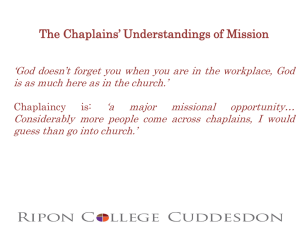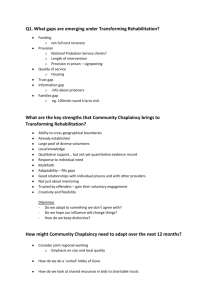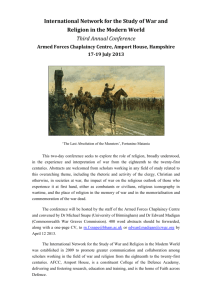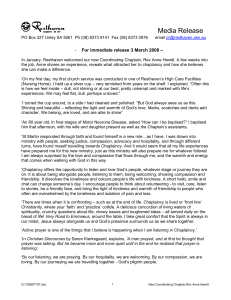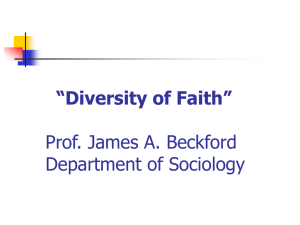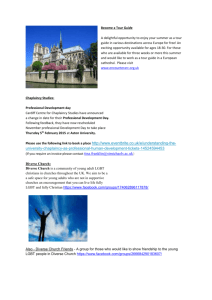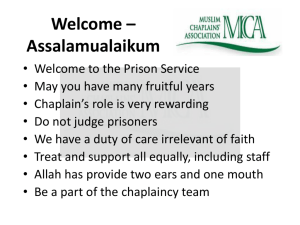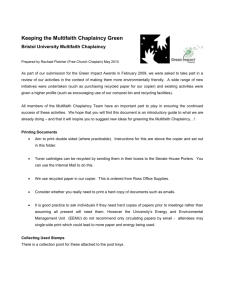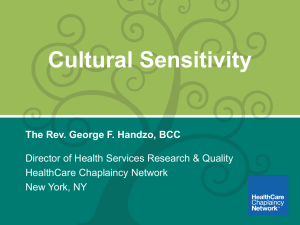Healthcare Chaplain: advocate for humanity or expert in spiritual care?
advertisement
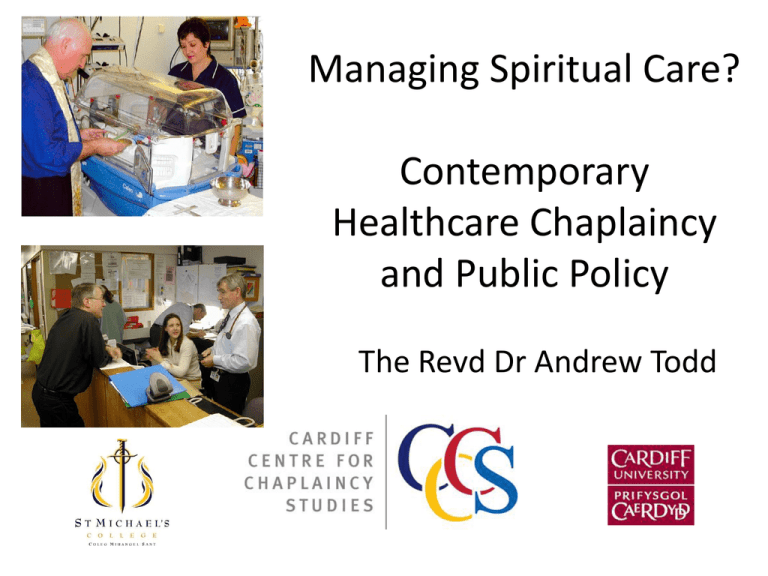
Managing Spiritual Care? Contemporary Healthcare Chaplaincy and Public Policy The Revd Dr Andrew Todd Assumptions & Approach • A consideration of the continuing ambiguity of chaplaincy – between faith communities, other organisations and public policy • Consideration of the framing of chaplaincy by organisational and political agendas – and the significance of current adaptations • Conclusions about healthcare chaplaincy now and the implications for understanding the interaction of religion, spirituality and health Historic Strength • Pastoral care rooted in attentive and inclusive listening – a non-judgemental approach to patients and staff • Earned respect that enabled a constructive critical engagement with the organisation • An amateur approach to healthcare – that enabled chaplains to see the human person • Holistic healthcare rooted in seeing the whole person Holistic healthcare Holistic healthcare – ‘a state of complete physical, mental and social wellbeing and not merely the absence of disease or infirmity’ (WHO Constitution 1946) Contextual Factors 1 • Multi-specialist healthcare - competitive • Evidence-based practice • Cost-benefit analysis and the drive for efficiency - economic finitude; hierarchies of provision? • Contested statutory basis for Chaplaincy • Contested public role – Worcester 2006 (Swift 2009); Data Protection (Welford 2011); NSS campaign Chaplaincy Adaptations 1 Finding a role within the organisation: • Professionalization • Capabilities and Competencies (NHS Education Scotland) • Assessment of spiritual care needs and appropriate intervention • Emerging statutory Basis for Chaplaincy – Scotland (from 2002); Wales (from 2010); England still working with 2003 Guidelines • Authorisation and Regulation (UKBHC and MFGHC) Outworking 1 • Re-positioning chaplaincy – a task-based approach with increased accountability • Specialist role with patients and relatives may occlude role with staff • Specialist approach may also work against connectedness and seeing the whole person • How does the chaplain relate now to the organisation – by becoming managers of a specialist spiritual care service? Contextual Factors 2 • Equality of opportunity and respect for diversity – ‘equal care for equal need’ • Patients’ rights; patient choice; patient experience – ‘no decision about me without me’ • Holistic healthcare – integrating the ‘spiritual’? • Perception of spirituality as individual need (alongside other healthcare needs) Chaplaincy Adaptations 2 Articulating contemporary chaplaincy practice: • Spiritual (as distinct from religious) care offered by chaplains, nurses, others • A response to human need for meaning, identity, hope… • Respects diversity of belief and patient choice • Offers equality of opportunity • Generates a chaplaincy role not limited to religion (alongside multi-faith provision) Spiritual Care ‘Listening to the patient’s experience and the questions that may arise; affirming the patient’s humanity; protecting the patient’s dignity, self worth and identity; ensuring that spiritual care is offered as an integral part of an holistic approach to health, encompassing psychological, spiritual, social and emotional care, and within the framework of the patient’s beliefs or philosophy of life.’ National Institute for Clinical Excellence (NICE) (2004). Improving Supportive and Palliative Care for Adults with Cancer: The Manual. Outworking 2 • More rhetoric than practice? (Swift, 2009) • Difficult to distinguish (Welford 2011) • Multi-faith and ‘generic’ models of chaplaincy (Todd 2011) • Subordinates religion (one way in which spirituality is expressed) • Characterises spirituality and religion as distinct • Marginalises chaplains’ ‘spiritual’ skills rooted in their religious practice • Individualisation of care may counter connectedness and therefore holism Consequences for Chaplaincy • In much of the above, chaplaincy speaks to those who run the NHS – less attention is paid to other audiences (especially the patient) • The evolving specialist language and role widens the gap between chaplaincy and more traditional faith practice • The scope for the ‘empty handed healer’ (Swift 2009) may be both wider (more ‘inclusive’) and more constrained (more task-based and accountable) • The humanitarian amateur may be out of fashion (but still in action)! Holistic healthcare? Elements of a shift of practice? • Professionalisation – a more instrumental specialism? • Compartmentalisation (religious/spiritual) • Implications for faith-based skills and the development of new skills (spiritual need assessment) • One specialism within multi-disciplinary healthcare, rather than a connecting humanity? • But – legitimatory rhetoric, not fully embedded in practice (yet!) References Welford, Layla. 2011. Spiritual Healthcare and Public Policy: An investigation into the legal and social policy frameworks of healthcare chaplaincy. Cardiff University, PhD Thesis Todd, Andrew. 2011. Responding to Diversity: Chaplaincy in a Multi-Faith Context, in ed. Miranda Threlfall-Holmes & Mark Newitt, Being a Chaplain. London: SPCK, 89-102 Swift, Chris. 2009. Hospital Chaplaincy in the Twenty-first Century: The crisis of spiritual care on the NHS. Farnham: Ashgate.
